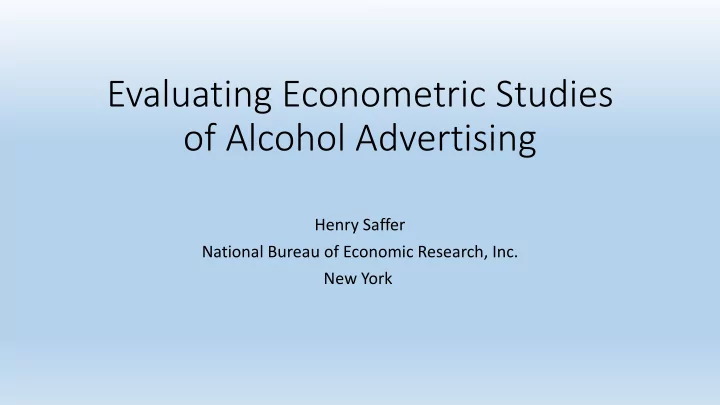

Evaluating Econometric Studies of Alcohol Advertising Henry Saffer National Bureau of Economic Research, Inc. New York
What are econometric studies? • Generally rely on regression analysis and secondary data. • Attempt to estimate the causal effect of a key variable on an outcome holding other variables constant. • Are concerned with the basis for causality, distributional properties of the data and individual differences.
What is advertising? Advertising is the use of traditional media to increase brand awareness and create positive associations with a brand with the goal of increasing its sales.
How much alcohol advertising is there in the US? The amount of advertising is measured by the advertising to sales ratio (A/S). The A/S for all alcoholic beverages is about 6.6% while the A/S for all industries is about 2.4%. Alcohol is advertised about three times as much as the average advertised good.
What is needed for a plausible empirical study? A treatment that is assigned at random to one group and not to another. Assignment is not dependent on the outcome of • interest. Treatment group and control group are on average the • same.
Econometric Studies The relationship is expressed with an equation: C = β0 +β 1 A + β 2 X + u (1) β 1 is the incremental effect of a unit increase in • advertising on consumption holding the variables in X constant. That is, β 1 is the incremental effect within the • categories defined in X
Conditions for Estimation of a Causal Effect of A on C • There is no causality from C to A. • There is no omitted third factor that affects C and A. • Other factors (X) are controlled. X A Other factors X Alcohol Ads X C A is exogenous if Alcohol these conditions X Use are meet. Omitted Third Factor
Approaches which may provide exogenous advertising 1)Targeting 2)Pulsing 3) Natural Experiment
1)Targeting • Targeting is spending relatively more of the total advertising budget on desired demographic groups. • Exogeneity is created by including demographics in X β1 is the effect of advertising on consumption within the groups defined by X.
2)Pulsing • The practice of randomly alternating between high and low levels of advertising. • Can provide a valuable source of exogenous variation for an econometric study.
3)Natural Experiment An empirical study in which some individuals are exposed to an event that occurs in nature or for reasons having absolutely nothing to do with the outcome of interest.
Does the existing econometric literature provide plausible results? Organized by type of secondary data: • Time Series -- time data only • Ad Ban Studies -- typically international data • Cross Sectional Studies – individual data
Time series studies have no controls for endogeneity Grabowski 1976 US 1956-1972 No effect of advertising Bourgeois and Barnes 1979 Canada 1951-1974 No effect of advertising McGuinness 1980 UK 1956-1975 Small positive effect of spirits advertising McGuinness 1983 UK 1956-1979 Small positive effect of beer advertising Duffy 1987 UK 1963-1983 No effect of advertising Franke and Wilcox 1987 US 1964-1984 quarterly Small positive effect of beer and wine ads Selvanathan 1989 UK 1955-1975 Small positive effect of beer advertising Duffy 1991 UK1963-1985 quarterly No effect of advertising Lee and Trembley 1992 US 1953- 1983 No effect of advertising Calfee and Scheraga 1994 France Germany, No effect of advertising Netherlands Sweden Duffy 1995 UK1963-1988 quarterly No effect of advertising Nelson and Moran 1995 US 1964-1990 No effect of advertising Blake and Nied 1997 UK 1952-1991 Small positive effect of advertising Nelson 1999 US quarterly No effect of advertising Duffy 2001 UK 1964-1996 quarterly No effect of advertising Wilcox, Kang and Chilek 2015 US 1971-2012 No effect of advertising
Ad ban studies have no controls for endogeneity Smart and Cutler 1976 British Columbia No effect of advertising Ogborne and Smart 1980 Manitoba No effect of advertising Makowsky and 1991 Saskatchewan No effect of advertising Whitehead Ornstein and 1985 US 1974-1978 Positive effect of price advertising Hanssens Saffer 1991 OECD 1970-1990 Negative effect of bans Young 1993 OECD 1970-1990 Mixed Miron 1999 US 1900-1995 No effect of ban during prohibition Nelson and Young 2001 OECD 1970-1990 Positive effect of bans Saffer and Dave 2002 OECD 1970-1995 Negative effect of bans Nelson 2010 OECD 1975-2000 No effect of ban
Cross Sectional Studies Pooled time series of cross sections of individuals. Endogeneity can be controlled with • demographic variables. The advertising data needs to be merged to • the individual records. Typically merged by local geocode which creates a measurement error problem.
Cross Sectional Studies Goel and Morey 1995 US 1959-1982 Mixed results Gius 1996 Brand level data No effect of ads US 1986-1989 Saffer 1997 Small positive effect of ads quarterly Saffer and Dave 2006 US 1996-1998 Small positive effect on youth consumption Saffer Dave and 2015 US 2002-2009 Small positive effect with heavy Grossman drinkers more responsive than moderate drinkers Molloy 2015 US 2000-2007 Small positive effect on youth consumption
Conclusion Most past studies of alcohol advertising do not provide plausible causal results. The most plausible econometric studies to date are the cross sectional studies, in particular, Molloy which has the best data for matching ads to individuals. Overall these studies show a small positive effect of alcohol advertising on total alcohol consumption.
Recommend
More recommend